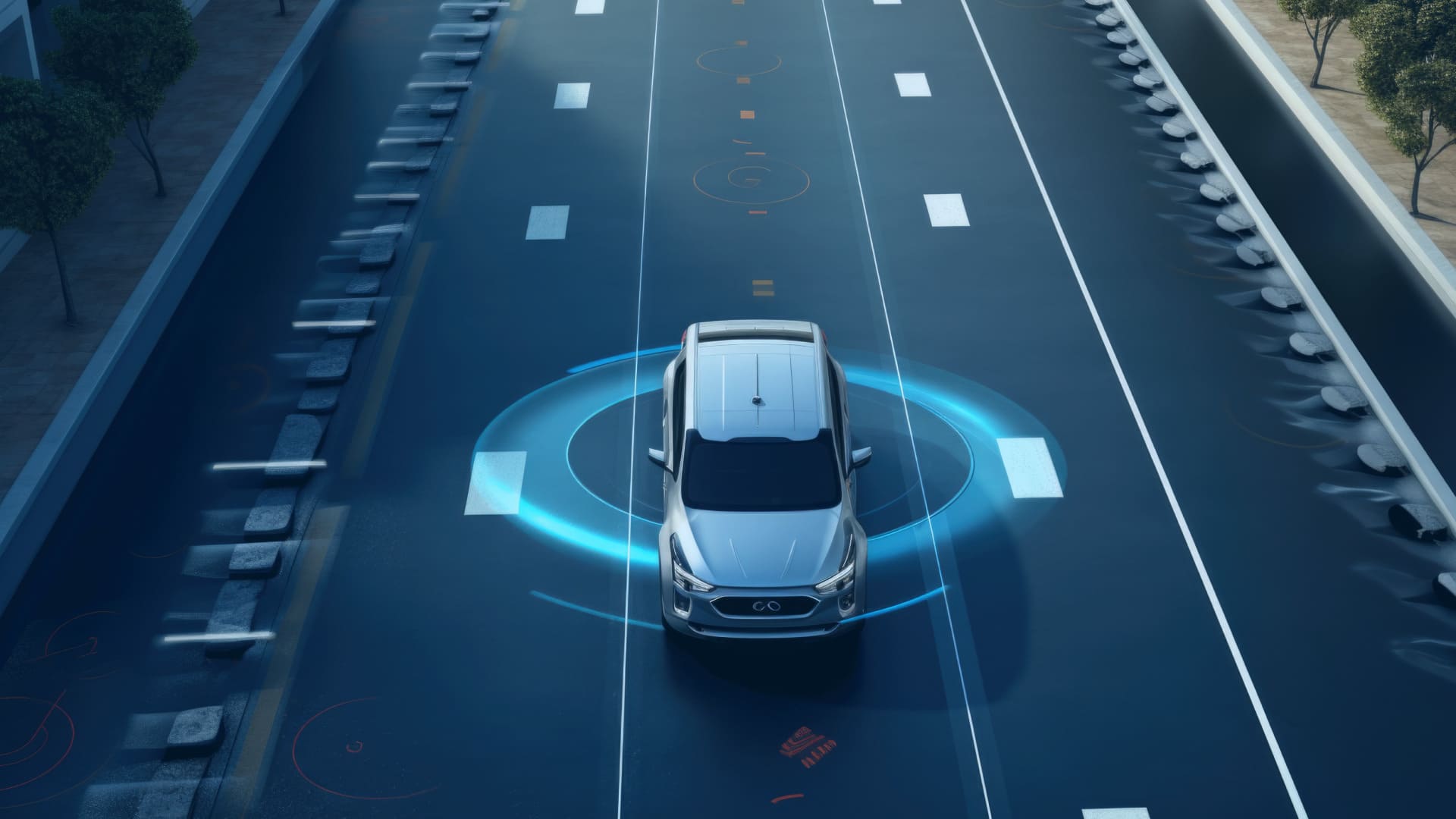In the rapidly evolving world of automotive technology, the rise of ADAS system in cars marks a significant leap forward in ensuring road safety and efficiency. Termed as the ‘invisible copilot,’ these systems are revolutionizing the way we perceive and interact with our vehicles. This blog will delve into the multifaceted world of ADAS in cars, shedding light on how they serve as life-saving technologies and how they seamlessly integrate with advanced fleet
What is ADAS?
Advanced Driver Assistance Systems (ADAS) are a collection of technologies and software that aid drivers in navigating and controlling vehicles more safely. These systems use a variety of sensors, cameras, and algorithms to detect surroundings and provide real-time information, warnings, and automatic interventions to prevent accidents. From automatic emergency braking to lane-keeping assistance, ADAS is like having an invisible, vigilant copilot by your side.
Components and Functionality
The backbone of ADAS technology is its sophisticated network of sensors and cameras. These components work in unison to provide a comprehensive understanding of the vehicle’s environment, enabling systems like adaptive cruise control to maintain safe distances from other vehicles, or lane departure warnings to alert drivers of unintentional lane changes. The integration of these technologies ensures that ADAS-equipped vehicles are not just reactive but proactive in their approach to safety.
The Importance of ADAS in Today’s Automotive Landscape
Enhancing Driver Safety
One of the most compelling arguments for the widespread adoption of Advanced Driver Assistance Systems (ADAS) is their undeniable impact on road safety. By providing drivers with critical information and automated support functions, ADAS technologies play a pivotal role in preventing accidents before they happen. Features such as emergency braking systems, which automatically engage to avoid collisions, and blind spot detection, which alerts drivers to unseen vehicles, are just a few examples of how ADAS directly contributes to reducing the incidence of traffic accidents. The statistics speak volumes, with numerous studies showing a significant decrease in collision rates for vehicles equipped with ADAS features. This safety enhancement is especially crucial for fleet vehicles, which spend extensive time on the road, increasing their exposure to potential accidents.
Improving Traffic Flow and Reducing Congestion
Beyond individual safety, ADAS technologies have the potential to transform the overall flow of traffic and mitigate congestion issues. By enabling more precise and efficient driving patterns, ADAS-equipped vehicles can maintain optimal speeds and distances from one another, reducing the stop-and-go driving behavior that often leads to traffic jams. Adaptive cruise control and lane-keeping assist are prime examples of how ADAS can smooth out traffic flow, contributing to a more efficient transportation system. This not only saves time for all road users but also significantly lowers fuel consumption and emissions, showcasing the broader environmental benefits of ADAS technologies.
Contributing to Environmental Sustainability
The environmental implications of widespread ADAS adoption cannot be overstated. By optimizing driving efficiency and reducing the likelihood of accidents, ADAS-equipped vehicles contribute to lower fuel consumption and decreased emissions. This is particularly relevant for fleets, where even minor improvements in fuel efficiency can lead to substantial cost savings and environmental benefits. Furthermore, the integration of ADAS with eco-driving systems can further enhance these environmental advantages, promoting driving habits that are not only safer but also more environmentally friendly.
The Life-Saving Benefits of ADAS in Cars
Enhanced Road Safety
ADAS significantly reduces the risk of accidents by providing features such as collision warnings, pedestrian detection, and blind-spot monitoring. By alerting drivers to potential hazards and even taking control in critical situations, these systems are actively saving lives every day.
Reduced Driver Fatigue
Features like adaptive cruise control and lane-keeping assist reduce the burden on the driver, especially during long journeys, leading to less fatigue and sharper focus on the road.
Improved Traffic Flow
By optimizing driving patterns and reducing the likelihood of accidents, ADAS contributes to smoother traffic flow, less congestion, and, as a result, a decrease in vehicle emissions.
Support for Elderly and Disabled Drivers
ADAS technologies offer additional support for elderly and disabled drivers, enhancing their ability to drive safely and maintain independence for longer.
ADAS and Trakzee: A Perfect Match
Our advanced fleet management software, Trakzee, integrates seamlessly with ADAS, offering a comprehensive solution that maximizes safety and efficiency. Here’s how Trakzee enhances the benefits of ADAS:
Real-Time Monitoring and Alerts
Trakzee’s real-time monitoring allows fleet managers to receive instant alerts about ADAS detections, enabling quicker responses to potential issues and fostering a proactive safety culture.
Data-Driven Insights
By collecting and analyzing data from ADAS, Trakzee provides valuable insights into driver behavior, vehicle performance, and overall fleet efficiency, empowering businesses to make informed decisions.
Enhanced Maintenance Scheduling
ADAS-equipped vehicles can predict maintenance needs and report them via Trakzee, ensuring that vehicles are always in top condition and reducing the risk of breakdowns.
Improved Compliance
With Trakzee, fleet managers can ensure that all vehicles comply with safety regulations and that drivers are adhering to best practices, as recommended by ADAS technologies.
Trends in ADAS in Cars : Steering Towards a Safer Future
The trends in ADAS system in cars are continually evolving, with new features and improvements being introduced regularly. Here are a few key trends:
Increased Automation
The move towards fully autonomous vehicles is on the horizon, with ADAS technologies laying the groundwork for this transition by gradually increasing levels of automation.
Integration with Other Technologies
ADAS is increasingly being integrated with other technologies like vehicle-to-everything (V2X) communication, which allows vehicles to interact with their environment for enhanced safety and efficiency.
AI and Machine Learning
The integration of AI and machine learning in ADAS systems is leading to smarter, more adaptive technologies capable of learning from vast amounts of data and improving over time.
Enhanced Sensor Technology
Improvements in sensor technology continue to enhance the accuracy and reliability of ADAS, making these systems even more effective in preventing accidents.
Implementation Challenges and the Way Forward
Despite the clear benefits, the widespread adoption of ADAS faces several challenges. These include high costs, lack of standardization, and concerns about reliability and privacy. Education and awareness are also key. As more people understand the benefits of ADAS and how systems like Trakzee can enhance these benefits, adoption rates are likely to increase. Additionally, regulatory support and incentives can accelerate the integration of these life-saving technologies into every vehicle.
Conclusion
Advanced Driver Assistance Systems are not just a technological advancement; they are a pivotal step towards safer, more efficient roads. As an invisible copilot, ADAS is continuously watching, warning, and acting to protect drivers, passengers, and pedestrians alike. When combined with advanced fleet management software like Trakzee, the potential to improve road safety and vehicle performance is immense.
As we look to the future, the trends in ADAS promise even greater advancements, with the potential to transform our driving experience entirely. Embracing these technologies today means being a part of a safer, more efficient, and more environmentally friendly tomorrow. Let’s drive forward together, with ADAS and Trakzee leading the way.
Frequently Asked Questions (FAQs)
What is ADAS in vehicles?
ADAS, or Advanced Driver Assistance Systems, are technologies and software that help drivers navigate and control vehicles safely. They use sensors and cameras to provide real-time information, warnings, and automatic interventions to prevent accidents.
How do ADAS system in car improve road safety?
ADAS improves road safety by offering features like collision warnings, pedestrian detection, lane-keeping assistance, and automatic emergency braking. These systems alert drivers to potential hazards and can take control in critical situations to prevent accidents.
Can ADAS systems reduce driver fatigue?
Yes, ADAS systems like adaptive cruise control and lane-keeping assist reduce the burden on drivers. Especially during long journeys, leading to less fatigue and a sharper focus on the road.
How does Trakzee integrate with ADAS?
Trakzee integrates with ADAS by offering real-time monitoring and alerts, data-driven insights, enhanced maintenance scheduling, and improved compliance. It enhances the benefits of ADAS by providing a comprehensive solution that maximizes safety and efficiency.
What are the current trends in ADAS technology?
Current trends in ADAS include increased automation, integration with other technologies like V2X communication. The use of AI and machine learning for smarter systems, and enhancements in sensor technology for better accuracy and reliability.
Are ADAS systems reliable and private?
ADAS systems are designed with reliability and privacy in mind, but concerns still exist. As technology advances, these systems are continually being improved to enhance reliability and address privacy concerns.
How does ADAS support elderly and disabled drivers?
ADAS technologies offer additional support for elderly and disabled drivers by providing features that enhance their ability to drive safely and maintain independence for longer.
What challenges does the adoption of ADAS face?
Challenges include high costs, lack of standardization, concerns about reliability and privacy, and the need for greater public education and awareness. However, as technology improves and costs decrease, these barriers are being addressed.
How can regulatory support influence ADAS adoption?
Regulatory support and incentives can accelerate the integration of ADAS into vehicles by setting standards. Offering incentives for adoption, and ensuring that all vehicles meet safety requirements.
Why is it important to understand ADAS and Trakzee?
Understanding ADAS and Trakzee is crucial for leveraging the full benefits of these technologies. Ensuring safer roads, and being part of the movement towards more efficient and environmentally friendly driving practices.



